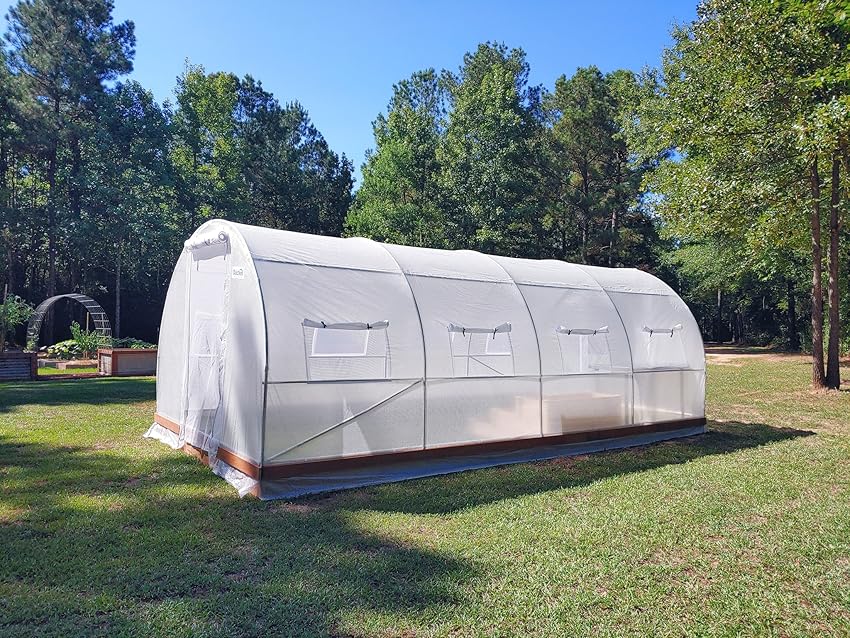Summer brings abundant sunlight and warmth, but for greenhouse owners, it also poses a significant challenge: overheating. Without proper temperature management, your plants can suffer from heat stress, stunted growth, or even death. Fortunately, with the right greenhouse ventilation techniques, cooling a greenhouse in summer doesn’t have to be a battle. This guide explores practical strategies to help you maintain a thriving, cool planting environment all season long.
Why Greenhouse Ventilation Matters in Summer
In the summertime, temperatures inside can soar 10–20°F higher than outdoors, creating conditions that wilt plants, reduce fruit yields, and attract pests like spider mites. Ignoring how to prevent overheating in a greenhouse will risk losing months of hard work, and understanding how to prevent overheating in a greenhouse is vital for success.
Effective summer greenhouse temperature control is about balance. Plants like warm weather, but warmth that gets too hot or cold is stressful. Hot or cold extremes really mess with photosynthesis, which is how they make their food, plus roots can also get in trouble. Just like how we're happier and healthier in a temperature that's neither too hot nor too cold, plants need balance to thrive.
The Best Ventilation Techniques for Hot Weather
Sure, to address those sweltering summer days, there are various greenhouse ventilation techniques and each comes with its own merits and times to use it.

Natural Ventilation
Natural ventilation relies on the principles of convection to passively regulate temperature. It's an energy-efficient and cost-effective method, making it a staple in many greenhouses. Achieving cooling a greenhouse in summer can be easier with natural ventilation.
Roof Vents
As hot air naturally rises, roof vents provide an escape route, allowing it to vent out of the greenhouse. The size and placement of roof vents are crucial for optimal performance. They should be placed where they rise up to the very tops of the roofs so that they can best pull heat away.
Side Vents
At the side of the greenhouse, there are some vents that draw cool air in from outside. When used in conjunction with roof vents, they create a natural cross-ventilation effect, flushing out hot air and replacing it with cooler, fresh air. Position side vents strategically to take advantage of prevailing winds for maximum efficiency.
Door Ventilation
Having the greenhouse door ajar, with vents on the roof plus sides, lets in extra airflow, kind of like open windows on a hot summer day. This is particularly useful during periods of intense heat, being one example of effective greenhouse airflow solutions.
Mechanical Ventilation
Using fans to blow air around the greenhouse is like powering a bigger and more focused air conditioner. This helps us cool things down inside much more efficiently and with finer control. These greenhouse airflow solutions can be customized to fit specific greenhouse needs. Finding the best greenhouse cooling methods often involves strategically placed fans.
Exhaust Fans
Exhaust fans are designed to actively expel hot air from the greenhouse. To select the right size, consider the CFM (cubic feet per minute) rating, which indicates the amount of air the fan can move. A general rule of thumb is to choose a fan that can exchange the entire volume of air in the greenhouse every 1-2 minutes.
Circulation Fans
For promoting consistent airflow and great, even temperatures in those greenhouses, circulation fans are really key. They knock down those cold spots and stop things from getting crowded and hot in one corner but cool in another too. Position these fans strategically to ensure that air circulates around plants, reaching all corners of the greenhouse.
Evaporative Coolers (Swamp Coolers)
Evaporative coolers, also known as swamp coolers, work by passing air through a wet pad. Evaporative coolers really shine when it's drier out and the air is pretty light and fluffy with very little moisture. But they do have the potential to really boost the humidity in the air a lot, and for some plants, that extra moisture isn't what they need at all. This is one consideration for summer greenhouse temperature control.
Automatic Vent Openers
Automatic vent openers are super clever gadgets that zip and unzip greenhouse vents automatically based purely on the temperature. These usual starters use a cylinder filled with wax, which expands and pushes open the vent when warmed up. As the temperature drops in autumn, the wax shrinks, which lets the vent close.
The benefits of automatic vent openers include consistent summer greenhouse temperature control and convenience. They streamline things by taking care of all those manual tweaks for you—ensuring that every vent is at just the right temperature and in the right position, always open or closed.
Additional Tips for Summer Greenhouse Cooling
Beyond just the ventilation, lots of different strategies can help keep it nice and cool in greenhouses.
Shade Cloths
Shade cloth functions like a shield, which takes the brunt of sunlight, letting less of that energy into the greenhouse. Shade cloths come in various materials and shading percentages (e.g., 30%, 50%, 70%). Higher amounts of shade provide more shade but also reduce the amount of light, and not all plants like that. Proper installation is key; ensure the cloth is securely fastened and positioned to provide maximum shade during the hottest part of the day. As previously mentioned, using shade cloths and fans to cool a greenhouse is a powerful combination and a critical component of summer greenhouse temperature control.
Watering Strategies
When it's really warm outside, having that regular watering makes a big difference in keeping the air in greenhouses cool and comfortable. Watering early in the morning allows plants to absorb moisture before the heat of the day sets in, helping them to cope with higher temperatures. Adding some water onto the floor of the greenhouse doubles the humidity slightly and also brings the temperature just a teeny bit down. But please don't go overboard here, because too much humidity encourages fungus to grow.
Greenhouse Location and Orientation
Ideally, a greenhouse should be positioned to receive maximum sunlight in the winter and some shade during the hottest part of the summer. Deciduous trees planted strategically can provide shade during the summer months while allowing sunlight to reach the greenhouse in the winter when the leaves have fallen. This is another way to implement greenhouse airflow solutions by design, leading to more effective cooling of a greenhouse in summer.

Reflective Materials
Reflective materials, such as aluminum foil or white plastic sheeting, can be used on the exterior or interior of the greenhouse to bounce back some of the sun's rays. This helps to lessen the amount of heat that’s absorbed right into the greenhouse and keeps temperatures lower inside, supporting cooling a greenhouse in summer.
Conclusion
Keeping my greenhouse cool in the summer all comes down to a good mix of creativity and science. Employing these methods ensures you effectively achieve summer greenhouse temperature control. Remember, the best greenhouse cooling methods combine multiple strategies.
Whether you’re a hobbyist or a commercial grower, investing in summer greenhouse temperature control ensures your plants stay healthy, productive, and resilient against the heat. Now’s the time to start doing these things and reap big rewards and a lively harvest all through the season!








